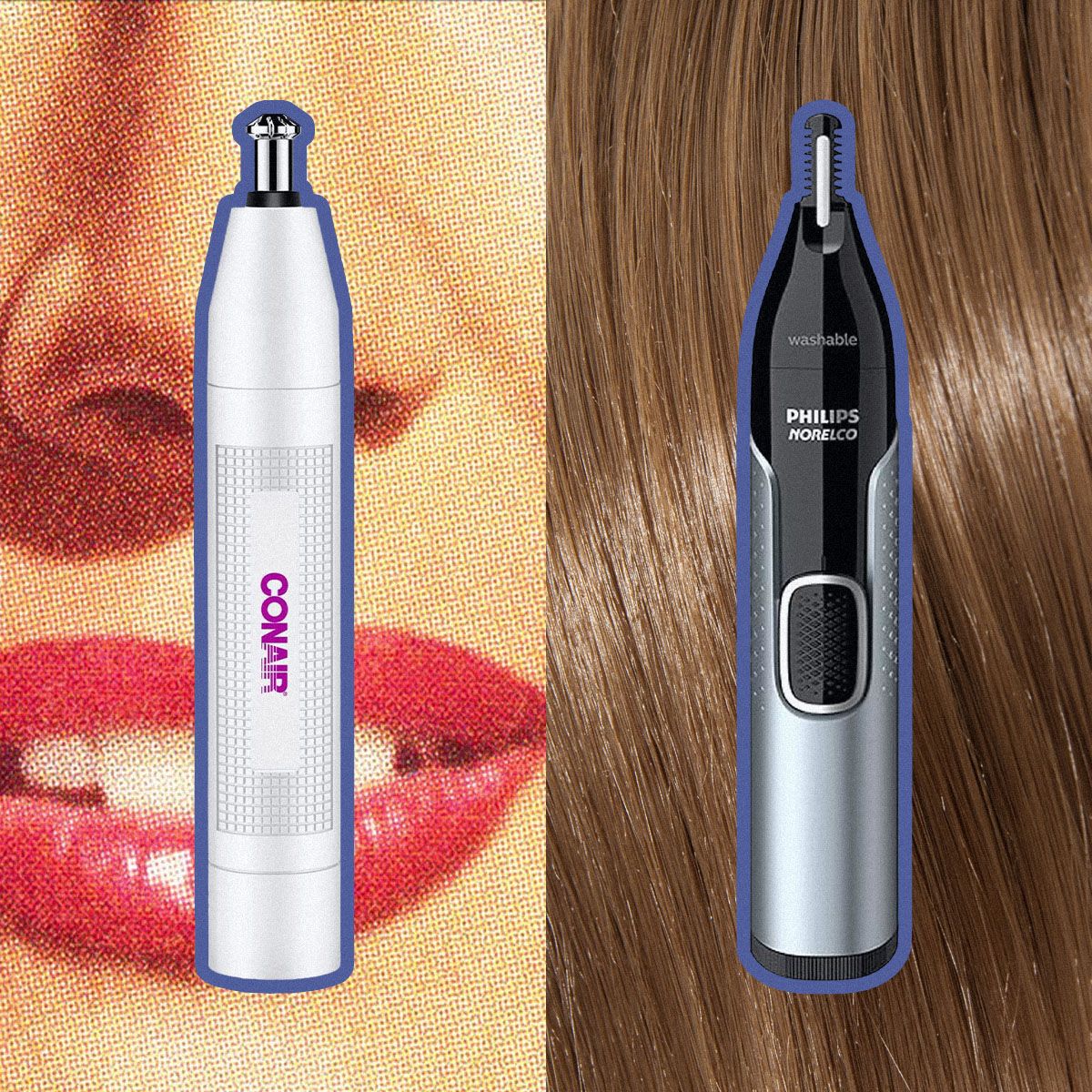
It’s interesting how, as a society, we’ve become more comfortable talking openly about body hair—underarms, bikini lines, facial fuzz—yet nose hair still feels off-limits. I’d group it with toe and knuckle hair: still taboo and still largely under-discussed considering everyone on Earth has it.
You might be wondering why someone would willingly attach their byline to a story about nose hairs. But as a Pakistani woman, body hair has always been intertwined with my identity, alongside my ongoing efforts to manage and remove it. And in many ways, I’ve succeeded. I’ve done it all in my attempt to become as smooth as a seal: in-person laser hair removal, at-home IPL, a wax pass from European Wax Center, Nair for the days I’m too lazy, and even a razor subscription from Billie. You name it, I’ve tried it.
But I never had an effective way to deal with nose hairs. They didn’t really bother me… until I caught a glimpse of myself under the unforgiving fluorescent lights of a fitting room. That day, I searched “how to trim nose hair,” and, like clockwork, my TikTok algorithm flooded me with targeted ads for every nose hair trimmer under the sun.
And while I know we’re technically free to do whatever we want with our body hair, I’m too deep in the trenches of this journey to turn back now. I genuinely admire those who feel zero pressure to remove any of theirs—more power to you if you’re in that camp. But in the interest in learning about my removal options, I spoke to a few board-certified experts about what nose hair actually does, whether plucking or waxing is truly dangerous, the safest ways to remove nose hair, and what to buy for if you’re ready to tackle yours.
What’s the Purpose of Nose Hair?
Our bodies are complex, with every feature serving a unique purpose, including nose hairs. While they may be considered unsightly by some, nose hairs play an important role in filtering the air we breathe. Board-certified dermatologist Teresa Song, MD, explains that nose hairs trap dust, pollen, and pathogens before they can enter the respiratory system. Board-certified dermatologist Dara Spearman, MD, adds that they help prevent contaminants from reaching the mucosal membrane and, ultimately, our lungs. In other words, they are an essential part of the body’s natural defense system.
What's the Safest Way to Remove Nose Hair?
- Prep the Area
Before you start, make sure your trimmer or scissors are clean. Good lighting and a mirror are essential so you can see exactly what you’re doing. Trimming nose hairs is generally easy, and once you get the hang of it, you can maintain them every one to two weeks.
- Use the Right Tool
When it comes to removal, experts agree trimming is the safest method. “You can trim nose hairs if they’re longer and tend to stick out. Just make sure the trimmers are specifically designed for the nose, are clean, and that you’re as gentle as possible to avoid any scraping or wounds,” says Dr. Spearman.
- Trim Carefully
Work slowly and only target the visible hairs that extend beyond the nostrils—never reach too deep. Dr. Spearman cautions against over-trimming, as this can lead to irritation and may disrupt the nose’s natural filtration system. “You can also use small scissors to trim nose hairs that aren’t quite long enough for a trimmer in between routine sessions,” she adds.
- Know When to Trim
There’s no strict rule about timing. “Trim as often as you’d like, as long as you’re using proper technique and keeping everything clean,” says Dr. Farishta. “Avoid trimming if you suspect any sort of infection.”
- Aftercare
Once you’re done, rinse your nostrils gently with warm water to clear away loose hairs. “Avoid picking or touching the area to prevent irritation,” recommends Dr. Song.
Plucking nose hairs can be dangerous. This is not a myth
Dr. Spearman
Otolaryngologist Daniel Z. Farishta, MD, adds that both scissors and electric trimmers can be safe options, as long as hygiene is prioritized. “Be sure to clean your tool with alcohol before and after each use to eliminate germs,” he says.
Is It Dangerous to Pluck or Wax Nose Hairs?
Unfortunately, the rumors are true—plucking or waxing nose hairs can be problematic. According to Dr. Spearman, “Plucking nose hairs can be dangerous. This is not a myth.” She explains that nose hairs act as a natural filter for the nose and respiratory system, so removing them at the root can make you more prone to breathing in harmful particles and allergens. Trimming, however, is generally considered safe because it shortens the hair without removing it entirely. “Removing nose hair can also result in ingrown hairs, which may become inflamed, irritated, or sore. And because the nose holds a lot of bacteria, plucking can transfer bacteria to the skin, which can then travel to the brain and lead to a serious infection of brain tissue,” she adds.
Dr. Song echoes the concern, noting that the base of the nose has a rich supply of blood vessels and is part of the “danger triangle” of the face. This area spans from the corners of the mouth to the bridge of the nose. Infections here, though rare, can potentially spread to the brain through connected veins. “Plucking can lead to folliculitis, ingrown hairs, and nasal vestibulitis, which is inflammation of the nasal lining. Waxing can be equally risky, as it often removes multiple hairs at once and may damage the delicate skin inside the nose, increasing the risk of infection,” she says.
If you’ve already plucked or waxed your nose hairs, don’t panic, but experts do recommend avoiding it in the future. “Signs of infection to watch for include pain, redness, bumps, nasal drainage, or pus. If you suspect a nasal infection, see your doctor right away to start antibiotics, which may be topical or oral,” advises Dr. Farishta.

What Should You Look for In a Nose Hair Trimmer?
All of our experts agree that nose trimmers are safe to use when chosen and maintained properly. Dr. Spearman recommends looking for a device with a rounded tip and an oscillating blade to minimize direct contact with the skin. “Always ensure the blade is cleaned properly, and I would advise against sharing any type of razor or trimming device [with another person],” she says.
Dr. Song suggests choosing a trimmer with rounded safety tips or protective guards to help prevent nicks. “A waterproof design is an added bonus for easy cleaning. Stick to reputable brands like Philips or Panasonic, and make sure to sanitize the trimmer head regularly,” she adds. You can do this by removing the blade and rinsing it under warm water, followed by soaking it in an isopropyl alcohol solution for a few minutes.
The Best Nose Hair Trimmers
Both drugstore and high-end trimmers are designed to help remove unwanted nose hairs, but there are key differences between them. While basic models cover the essentials, high-end versions may include added features like built-in lights, quieter motors, vacuum systems for tidier grooming, and attachments for other areas of concern, such as the eyebrows, explains board-certified dermatologist Brendan Camp, MD.
This easy-to-use nose trimmer also works for the ear area if you choose to go there. It’s compact, so it doesn’t take up too much space in the bathroom, to my roommate’s delight. You can use it wet or dry, and it’s cordless and comfortable to hold once you get the hang of it. I was worried it would be loud and alert everyone to what I was doing (as if this story isn’t already loud enough), but it’s actually pretty quiet so you can trim in peace.
The branding on this is very MAN <3 MEN <3, but I did what every 28-year-old woman dreams of and tested it out anyway. Turns out, the men were onto something with their grooming tools. This one has a 7,000 RPM motor and a 360 degree rotary dual-blade system that gives you a clean, close cut. I was a little intimidated at first, but the matte, rubberized grip makes it easy to maneuver. It can also be used wet or dry, which is always a plus.
Thankfully, the branding on this one leans more feminine—so if that matters to you, welcome. The system is designed to make it really difficult to nick yourself, and the angled tip helps you reach every nook and cranny with ease. It’s also surprisingly quiet and removes hair quickly, which is all you can really ask for.
If you want to bring out the big guns, this multipurpose trimmer is for you (it’s the 5000 version, after all). Not only does it work for nose hairs, but it also comes with interchangeable heads for ear and eyebrow grooming, making it more versatile than some of the other options. It features dual-sided steel blades that cut unwanted hair cleanly without pulling, so you don’t have to worry about irritation or potential infections.
This is a great entry-point nose trimmer if you’re not planning to use it super regularly. It’s fully waterproof, so you can use it in the shower, and it also self-cleans to help extend its lifespan. It even comes with an eyebrow comb, making it a solid bang-for-your-buck option.
So, Is It a Good Idea to Remove Your Nose Hair?
Per our experts, it is generally not recommended to pluck or wax nose hairs. As Dr. Camp explains, the inside of the nose is lined with a mucous membrane, and nose hairs play an important role in collecting debris, pollutants, and bacteria, keeping them away from these delicate tissues. “Waxing this area can damage the integrity of the membrane and predispose the skin to infection or inflammation,” he says. If you want to manage nose hair for aesthetic reasons, the safest approach is to trim them routinely and ensure that all your tools are clean and hygienic. But if you follow all of this expert advice, there's no reason to let your nose hairs run wild if you don't want them to.
Why Trust Marie Claire
For more than 30 years, Marie Claire has been an internationally recognized destination for news, fashion, and beauty trends, investigative packages, and more. When it comes to the products Marie Claire recommends, we take your faith in us seriously. Every product that we feature comes personally recommended by a Marie Claire writer or editor, or by an expert we’ve spoken to firsthand.







